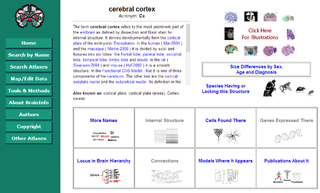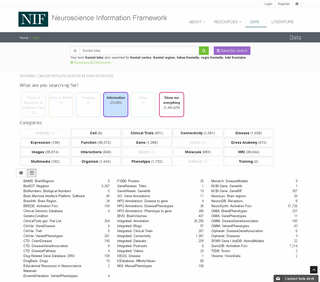 W
WAnatomography is an interactive website which supports generating anatomical diagrams and animations of the human body. The Anatomography website is maintained by the DBCLS non-profit research institute located at the University of Tokyo. Anatomical diagrams generated by Anatomography, and 3D polygon data used on the website, are freely available under the Creative Commons Attribution-ShareAlike license.
 W
WBioDigital is a New York-based biomedical visualization company that is often referred to as being "Google Earth for the Human Body". BioDigital offers an interactive, 3D software platform that enables individuals and business to explore and visualize health information. Their flagship product, the BioDigital Human, is a "searchable, customizable map of the human body".
 W
WBrainMaps is an NIH-funded interactive zoomable high-resolution digital brain atlas and virtual microscope that is based on more than 140 million megapixels of scanned images of serial sections of both primate and non-primate brains and that is integrated with a high-speed database for querying and retrieving data about brain structure and function over the internet.
 W
WNeuroLex is a dynamic lexicon of neuroscience concepts. It is a structured as a semantic wiki, using Semantic MediaWiki. NeuroLex is supported by the Neuroscience Information Framework project.
 W
WNeuroNames is an integrated nomenclature for structures in the brain and spinal cord of the four species most studied by neuroscientists: human, macaque, rat and mouse. It offers a standard, controlled vocabulary of common names for structures, which is suitable for unambiguous neuroanatomical indexing of information in digital databases. Terms in the standard vocabulary have been selected for ease of pronunciation, mnemonic value, and frequency of use in recent neuroscientific publications. Structures and their relations to each other are defined in terms of the standard vocabulary. Currently NeuroNames contains standard names, synonyms and definitions of some 2,500 neuroanatomical entities.
 W
WThe Neuroscience Information Framework is a repository of global neuroscience web resources, including experimental, clinical, and translational neuroscience databases, knowledge bases, atlases, and genetic/genomic resources and provides many authoritative links throughout the neuroscience portal of Wikipedia.
 W
WThe Visible Human Project is an effort to create a detailed data set of cross-sectional photographs of the human body, in order to facilitate anatomy visualization applications. It is used as a tool for the progression of medical findings, in which these findings link anatomy to its audiences. A male and a female cadaver were cut into thin slices which were then photographed and digitized. The project is run by the U.S. National Library of Medicine (NLM) under the direction of Michael J. Ackerman. Planning began in 1986; the data set of the male was completed in November 1994 and the one of the female in November 1995. The project can be viewed today at the U.S. National Library of Medicine in Bethesda, MD. There are currently efforts to repeat this project with higher resolution images but only with parts of the body instead of a cadaver.